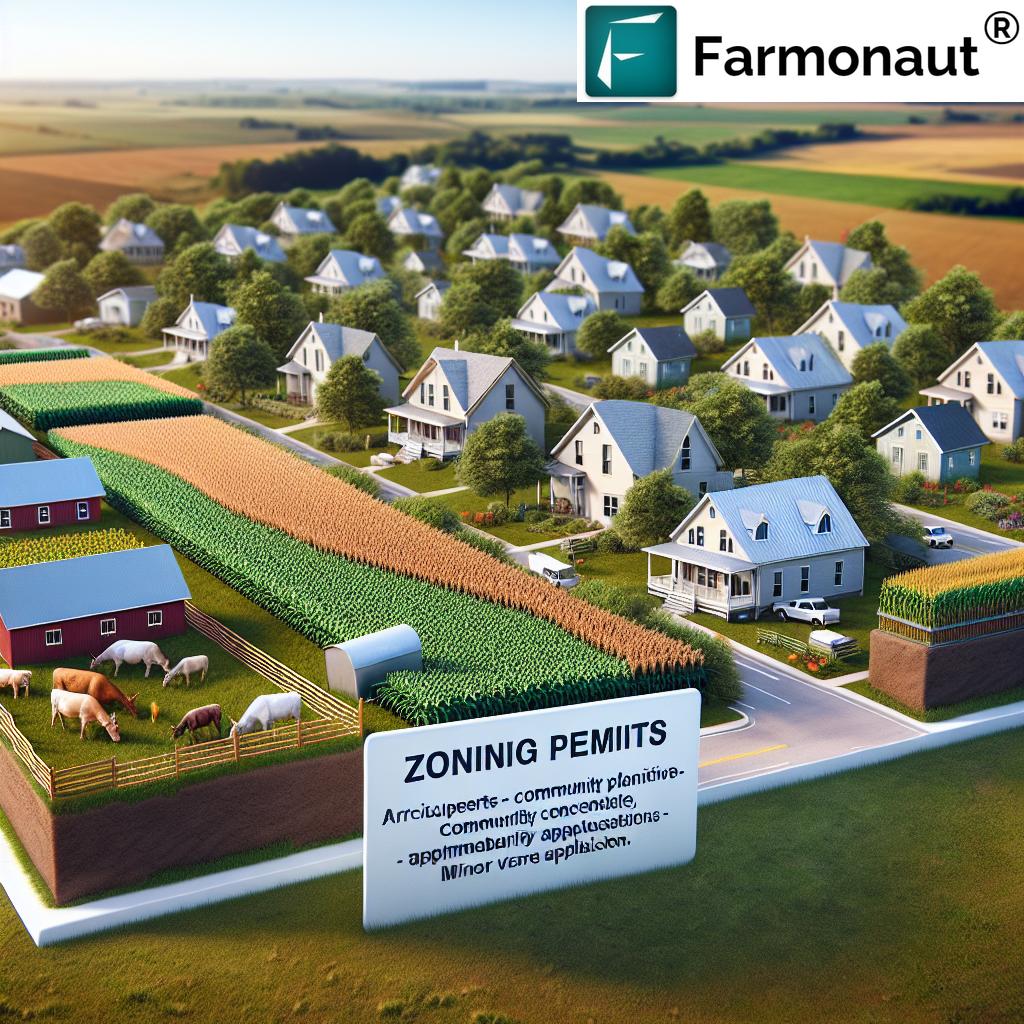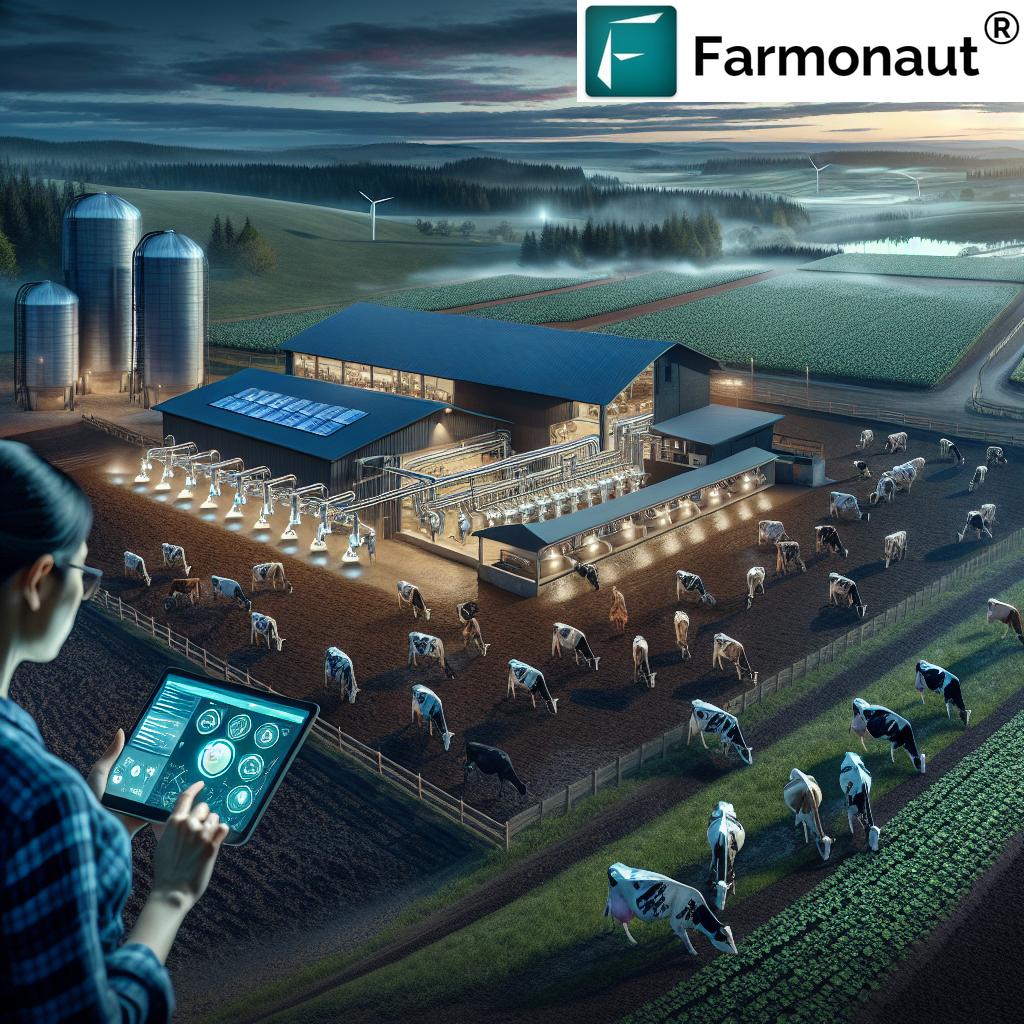” In 2023, Mapleton’s Committee of Adjustment reviewed over 40 zoning permit applications impacting local farming operations. ”
Committee of Adjustment Sparks Change in Mapleton Zoning Permits
In the heart of Wellington County, the township of Mapleton has once again demonstrated its deep connection to local agriculture by putting its committee of adjustment back in the spotlight. As questions and concerns swirl around Mapleton council planning strategies, amendments to the zoning bylaw process, and the future of agricultural permits in Mapleton, we’re diving deep into how these civic decisions are shaping our farming community—and the broader landscape of municipal land use planning.
From the intricacies of minor variance applications to bold discussions about adopting a community planning permit system (CPP), this comprehensive update explores it all. Alongside this, we’ll also see how leading-edge technology, such as that provided by Farmonaut, continues to become ever more vital to our evolving farming operations.
Understanding the Committee of Adjustment in Mapleton
Anytime we discuss zoning permits in Mapleton, we’re inevitably pulled into the orbit of the committee of adjustment. This local body is fundamental for interpreting, applying, and granting exceptions—commonly known as minor variance applications—to the township zoning bylaws. This committee isn’t just a bureaucratic “middle-man”; instead, it’s an essential bridge between our residents and the legal guidelines designed to support sustainable community growth, especially where farming and livestock operations are prevalent.
What is the Committee of Adjustment?
- Independent Body: Typically consisting of five appointed members who operate separately from Mapleton council.
- Main Functions: Reviews and decides on minor variances from the township’s zoning bylaw, as well as land severance applications.
- Focus on Agriculture: Given Mapleton’s rural character, a significant portion of applications relate to agricultural permits, barn expansions, and housing for livestock.
- Supports Both Residential and Agricultural Needs: Promotes balanced development, resolving issues where residential and agricultural zoning collide.
This setup ensures local voices are heard in the zoning bylaw process and brings relevant expertise to unique, Mapleton-specific contexts. The recent debate about whether to maintain, dissolve, or replace this committee with a community planning permit system (CPP) underscores just how integral it is to life here.
Timeline: Recent Mapleton Council Decisions on Adjustment and Zoning Systems
- Early 2024: Council floated a proposal to dissolve the committee of adjustment by March 31, 2025.
- Resident Response: Letters like Liz Samis’s highlighted the committee’s unique value, especially for local farming operations and the interpretation of complex zoning bylaws.
- Council Debate: Councillors Lori Woodham and Michael Martin advocated to maintain the status quo, reflecting significant community concern.
- Latest Ruling: Council reversed its position—reinstituting the committee, while exploring ways to make its processes even more effective (e.g., mandatory training for new members).
- Amendment Passed: Council added requirements for committee member training via township bylaw amendment.
- Current Task: The township now seeks a replacement for Woodham on the committee, following her move to council.
The dilemma for Mapleton has clearly been finding the most community-focused balance between traditional oversight and administrative efficiency—all within an agricultural context where zoning bylaw process is directly tied to operational viability.
Key Local Voices in the Debate
- Liz Samis (Resident): Advocated for the committee’s ongoing presence to foster deeper public understanding of agricultural variances and township bylaws.
- Coun. Lori Woodham: Repeatedly voiced that the current system “works well,” emphasizing that not all zoning challenges can be streamlined to fit a CPP model.
- Coun. Michael Martin: Expressed skepticism about one-size-fits-all planning tools, especially given the complexity of residential and farming issues.
” Mapleton’s zoning bylaw changes affected 15% of council planning decisions last year, shaping community development trends. ”
Committee’s Role in Mapleton Council Planning and Zoning Bylaw Process
The committee of adjustment is the linchpin that connects Mapleton council planning decisions to real-world farming, residential expansion, and local business growth. Let’s examine how its responsibilities play out in our community:
1. Reviewing Minor Variance Applications
- Common variances include building barn additions, new greenhouses, or exceptions to setback requirements for livestock facilities and agricultural buildings.
- Helps residents navigate conflicts arising from strict zoning bylaw language and practical operational needs.
- Ensures community development remains both flexible and consistent with township goals.
2. Balancing Residential and Agricultural Zoning
- Mapleton is unique, with vibrant agricultural operations coexisting with growing residential areas.
- The committee interprets local bylaws to ensure fair treatment for both, resolving disputes efficiently.
3. Advising Council on Bylaw Amendments
- Informs Mapleton council planning by identifying emerging trends from permit applications.
- Directly shapes legislative changes, such as recently proposed township bylaw amendments for training requirements and permit processing.
4. Community Engagement and Education
- Supports ongoing resident education around the zoning process, enhancing transparency and trust in municipal land use planning.
- Acts as a forum where residents and local farmers feel heard and actively involved in guiding Mapleton’s future.
Impact on Local Farming Operations & Agricultural Permits Mapleton
With over 40 applications pertaining directly to local farming operations annually, it’s clear that decisions made by the committee of adjustment ripple across everything from barn expansions to crop area management. Here’s how the committee’s existence—and the ongoing zoning bylaw process—shapes the agricultural backbone of Mapleton:
Seamless Application Review for Agricultural Permits Mapleton
- The committee streamlines reviews, ensuring small changes (like minor structure expansions) don’t stall farm business.
- Applicants receive context-specific advisories, thanks to local expertise on Mapleton-specific agricultural realities.
Protecting Livelihoods & Supporting Growth
- Supports environmental sustainability and economic security by enabling measured changes for livestock and crop operations.
- Fosters a predictable, yet adaptable, regulatory landscape for both established and up-and-coming farms.
Community-Driven Agricultural Policy
- Ensures community voices influence zoning bylaw amendments, which directly affect day-to-day farming practice and long-term land use.
With Mapleton’s agricultural permits forming the bulk of permits handled each year, any change in the committee’s structure—such as its now-defunct proposal to move to a community planning permit system—would have uniquely outsized impacts here as compared to more urbanized municipalities.
The Community Planning Permit System (CPP): Considerations for Mapleton
While the community planning permit system (CPP) is heralded by some as a streamlined alternative for municipalities, our council’s recent debate shows it’s not always a perfect fit—especially in places where farming operations and customized regulatory guidance are the rule, not the exception.
What is the CPP?
- A single-application, integrated approval system that consolidates zoning, site plan, and minor variance processes into one.
- Intended to offer faster, more predictable decisions, especially in rapidly expanding municipalities.
- Criticized in Mapleton as overly generic and lacking the nuanced touch needed for agricultural zones.
Mapleton’s council planning process ultimately supported sticking with the current committee of adjustment, citing the need for a system that accommodates the unique mix of farms, residential spaces, and small businesses that make up our community.
Feedback from Mapleton Residents: “Residential and Farming Issues Are Not the Same”
Community feedback, such as that from Liz Samis, underscores that land use requirements for livestock and residential zones are fundamentally different. Preserving a locally managed, context-aware committee ensures informed, democratic decisions unlike any automated or “streamlined” CPP model.
Training and Membership Amendments: Building Effective Committees
With change comes adaptation. Mapleton’s decision to maintain its committee of adjustment also brings renewed focus on ensuring committee members are well-trained and constantly informed—a move strongly suggested by Coun. Woodham and formalized in a township bylaw amendment.
Key Aspects
- Mandatory Training: While courses and learning modules are currently available, they will soon be a formal requirement for new committee members.
- Updated Membership: With Woodham’s transition to council, the township is actively searching for a qualified new committee member, ideally with deep ties to local farming or municipal land use planning.
For residents and agricultural property owners, this means even greater expertise when submitting minor variance applications or navigating the intricacies of zoning bylaws.
Did you know? Mapleton’s new member selection process now explicitly favors candidates with a strong understanding of local agricultural operations, heightening the committee’s relevance to the majority of permits processed each year.
Comparison Table: Zoning Permit Changes & Impact on Local Farming
| Permit Scenario | Permit Requirement (Before) | Permit Requirement (After) | Estimated Processing Time | Impact on Farming Operations | Estimated Applications/Year |
|---|---|---|---|---|---|
| Barn Expansion | Application to committee of adjustment; public notice required |
Unchanged; plus mandatory training for committee members | 3–6 weeks | More efficient/transparent reviews, tailored to agricultural needs | 15–18 |
| Greenhouse Installation | Minor variance via committee |
Same process; improved clarity on bylaw requirements | 2–5 weeks | Reduced confusion for applicants; greater support | 8–10 |
| Land Rezoning for Crop Use | Variance/rezoning considered by committee; council review | Unchanged; process more codified through training/amendment | 4–8 weeks | Greater consistency in approval and feedback | 6–8 |
| Residential Setback Variance | Reviewed by committee | Reviewed by better-trained committee; public information session introduced | 2–4 weeks | Improved public awareness and engagement | 3–6 |
| Livestock Housing Expansion | Variance required; agricultural consultation as needed | Process unchanged; improved documentation and transparency | 3–6 weeks | Boosted farmer confidence and accountability | 7–9 |
Farmonaut & Mapleton: Technology-Driven Future for Agriculture
As Mapleton’s regulatory systems adapt, it’s clear that supporting local agriculture goes beyond legislative tweaks—it demands smart, modern solutions to maximize yield, sustainability, and transparency. This is where Farmonaut steps in, advancing the integration of precision agriculture tools across our farm operations.
Precision Agriculture & Real-Time Monitoring
- Satellite-based crop health monitoring allows farmers to monitor vegetation health, soil moisture, and more—crucial for quick decision-making, especially when permit or zoning variances are pending.
- This technology reinforces the value of swift variance processes: when the committee of adjustment expedites minor variance applications, farmers can act efficiently on data-driven insights, maximizing crop cycles without regulatory lag.
Jeevn AI Advisory System
- Farmonaut’s Jeevn AI delivers localized, real-time advisories—adapting to Mapleton’s weather, soil, and regulatory requirements.
- Our farmers benefit from up-to-date guidance, which is even more critical as zoning bylaw shifts or local operational needs change.
Blockchain-Based Traceability
- With the evolving landscape of agricultural permits in Mapleton, blockchain-driven traceability offered by Farmonaut lets agribusinesses and consumers track the entire journey from farm to fork—improving trust and transparency.
Fleet and Resource Management
- Fleet management tools optimize logistics, reduce operational costs, and ensure machinery is deployed where needed—helping Mapleton’s farmers leverage zoning flexibility after receiving committee approvals.
Carbon Footprinting
- As sustainability standards increasingly shape bylaws, Farmonaut’s carbon foot-printing solution enables Mapleton agribusinesses to track and minimize their environmental impact—linking regulatory compliance straight to operational decisions.
Accessibility: Farmonaut’s platform is available on the web, Android, and iOS. Farmers, agribusinesses, and developers can also integrate satellite and weather data into their systems via the Farmonaut API and developer documentation, creating endless opportunities for smart farming across Mapleton and beyond.
Large-Scale Farm Management, Plantation, and Forest Advisory
For those in Mapleton looking to manage expansive agricultural lands, Farmonaut’s large-scale farm management solution offers integrated admin and management capabilities, furthering our township’s edge in sustainable productivity.
Frequently Asked Questions: Committee of Adjustment, Permits, and Planning in Mapleton
The committee of adjustment oversees all minor variance applications to the township’s zoning bylaw, as well as land severance and some specialty permit requests. It acts as an independent, community-focused decision maker, particularly important for our local agricultural sector.
How do committee decisions affect farming operations?
Since most permit applications are agricultural, decisions directly influence how farmers expand barns, modify livestock facilities, or adjust land usage—ensuring they remain agile and compliant within Mapleton zoning regulations.
What is the difference between the committee of adjustment and the CPP system?
The committee offers local, hands-on review and adaptation of permits, prioritizing agriculture-based realities. The community planning permit system (CPP) centralizes and supposedly “streamlines” decisions, but may lack the nuance needed for our unique rural economy.
Are there new requirements for committee members?
Yes, following a recent township bylaw amendment, new committee members must now undergo mandatory training to deepen their expertise in municipal land use planning and the zoning bylaw process.
How do Farmonaut’s solutions fit into Mapleton’s planning?
Farmonaut provides satellite imagery, AI-powered analysis, and management tools, giving Mapleton’s farmers data-driven insights to support both daily operations and long-term planning—making full use of updated zoning flexibility and permit structures.
Conclusion: Local Engagement and Zoning Innovation
Mapleton’s experience this year proves that real progress—whether in council planning, the zoning bylaw process, or supporting the next wave of local farming operations—relies on listening to community voices. By keeping the committee of adjustment and strengthening its processes with mandatory training and specialized selection, our township has chosen a future where transparency, flexibility, and agricultural innovation continue to thrive.
At Farmonaut, we support this direction by making precision agriculture tools accessible, affordable, and adaptable—fueling a new era of sustainable yield, resource management, and economic vitality in Mapleton and beyond. To learn more or empower your farm with advanced monitoring and advisory services, explore our app, visit our API platform, or leverage our carbon foot-printing resources for greener operations.
Mapleton’s zoning journey isn’t just a story about bureaucratic change—it’s the ongoing evolution of our community’s heartbeat. And with the right mix of local governance and agri-technology, we’re poised to prosper for generations to come.


















